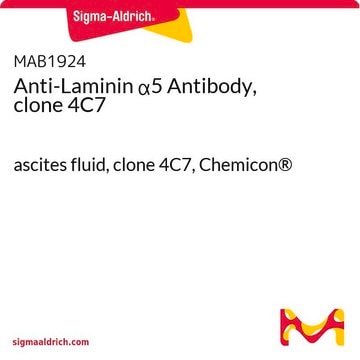MAB4360
Anti-TRA-1-60 Antibody, clone TRA-1-60
clone TRA-1-60, Chemicon®, from mouse
Synonim(y):
TRA-1-60 Marker
About This Item
Polecane produkty
pochodzenie biologiczne
mouse
Poziom jakości
forma przeciwciała
purified antibody
rodzaj przeciwciała
primary antibodies
klon
TRA-1-60, monoclonal
reaktywność gatunkowa
human
producent / nazwa handlowa
Chemicon®
metody
flow cytometry: suitable
immunocytochemistry: suitable
immunofluorescence: suitable
immunoprecipitation (IP): suitable
western blot: suitable
moc wejściowa
sample type induced pluripotent stem cell(s)
sample type: human embryonic stem cell(s)
izotyp
IgM
Warunki transportu
wet ice
docelowa modyfikacja potranslacyjna
unmodified
informacje o genach
human ... PODXL(5420)
Powiązane kategorie
Opis ogólny
Specyficzność
Immunogen
Zastosowanie
Western Blot: A previous lot of this antibody was used in WB.
Immunoprecipitation: A previous lot of this antibody was used in IP.
Immunohistochemistry: A previous lot of this antibody was used in IH.
Flow Cytometry: A starting range of 10-20 µg/mL is suggested.
Optimal working dilutions must be determined by the end user.
Stem Cell Research
Pluripotent & Early Differentiation
Opis wartości docelowych
Postać fizyczna
Przechowywanie i stabilność
Komentarz do analizy
NTERA-2 cl.D1 whole cell lysate (pluripotent stem cells derived from teratocarcinoma and are considered the malignant counterparts of human embryonic stem cells)
Inne uwagi
Informacje prawne
Oświadczenie o zrzeczeniu się odpowiedzialności
Not finding the right product?
Try our Narzędzie selektora produktów.
Kod klasy składowania
12 - Non Combustible Liquids
Klasa zagrożenia wodnego (WGK)
nwg
Temperatura zapłonu (°F)
Not applicable
Temperatura zapłonu (°C)
Not applicable
Certyfikaty analizy (CoA)
Poszukaj Certyfikaty analizy (CoA), wpisując numer partii/serii produktów. Numery serii i partii można znaleźć na etykiecie produktu po słowach „seria” lub „partia”.
Masz już ten produkt?
Dokumenty związane z niedawno zakupionymi produktami zostały zamieszczone w Bibliotece dokumentów.
Produkty
Skip weekend feedings. Defined serum-free and feeder-free expansion media for human pluripotent stem cells (ES and iPS cells). See publications and protocols.
Fibroblast growth factors (FGFs) regulate developmental pathways and mesoderm/ectoderm patterning in early embryonic development.
Czynniki wzrostu fibroblastów (FGF) regulują szlaki rozwojowe i kształtowanie mezodermy/ektodermy we wczesnym rozwoju embrionalnym.
The Simplicon™ RNA Reprogramming Technology is a next generation reprogramming system that uses a single synthetic, polycistronic self-replicating RNA strand engineered to mimic cellular RNA to generate human iPS cells.
Nasz zespół naukowców ma doświadczenie we wszystkich obszarach badań, w tym w naukach przyrodniczych, materiałoznawstwie, syntezie chemicznej, chromatografii, analityce i wielu innych dziedzinach.
Skontaktuj się z zespołem ds. pomocy technicznej







